Purpose of the Parthenon
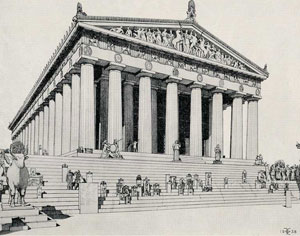
The Parthenon, the house of the Parthenos (virgin) Athena, is the most splendid building on the Acropolis of Athens.
It is not only impressive from a technical and artistic point of view nor as a magnificent edifice for religious worship; it is, simply put, the realisation, the embodiment one could say, of Classical ideals, the model which for centuries has personified the grandeur of Athens at the time of Pericles.
It is a manifestation of the many historical events which played a part in its construction. These were: the political and military might of Athens, the presence of an inspirational and brilliant personality such as Pericles, the events of the Persian Wars and the special contributions of the Athenians not only to the Greek world, but to Europe as well, in managing to repel the "barbarians". Furthermore, there were the exploitation of the Laurion mines with the wealth that they brought, the removal of the treasury of the Delian League from Delos to Athens, as well as the need the Athenians felt to express their gratitude to their patron goddess Athena. At the same time, as far as art is concerned, many exceptional Greek artists were active and artistic expression was reaching its peak, having broken the boundaries imposed on it by the conventions of the Archaic period and of the austere style. The finest examples of this style were in those days buried in storage areas on the sacred rock so that superb new buildings could be built in honour of the virgin goddess, Athena. There were Phidias, Ictinus, Callimachus, Agoracritus, Alcamenes, Cresilas and many others who, with their designs and craftsmanship on such fine material, the white marble of Pendeli, created what must be considered the peak of perfection throughout the ages in the field of art. The Parthenon is imbued with harmony, beauty, expressiveness, grace, symbolism; there is true mastery in its conception, planning and realisation. Although it was an expression of the people of Athens in the mid 5th century BC, it remains timeless.
Parthenon History
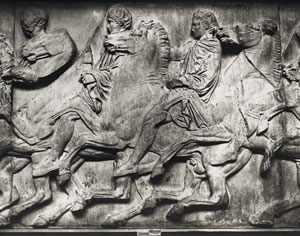
It was opened to the public in 438 BC during the great Panathenaean Games, although the sculpted decorations had not yet been completed, as we know from inscriptions that have survived; it is thought that these were finished in 432 BC.
To a great extent, the Parthenon has been preserved in excellent condition for more than 2,000 years. A fire, possibly in the 2nd AD century, caused damage to the building and the statue of the goddess made of ivory and gold. Mention is made that in 160 BC the statue of the virgin goddess by Phidias was replaced, paid for by the king of Syria, Antiochus IV.
During the reign of the Roman emperor Julian the Apostate, AD 362-363, some attempts at repairs were made within the framework of reviving the old religion, i.e. paganism, but in the 5th century AD, following and edict by the Emperor Theodosius II, the Parthenon ceased to be a temple dedicated to the goddess Athena and was turned into a Christian church dedicated originally to Ayia Sophia (Holy Wisdom) and then to the Virgin Mary. Alterations were restricted to the interior. The entrance was moved from the east to the west side and the ceiling became vaulted. On the whole, the building retained its original form. Although some of the wall paintings of the Orthodox church have survived, they are somewhat faded.
At the beginning of the 13th century, it was turned into the Catholic church of Notre Dame and in 1458 it became a Muslim mosque under the Ottomans. In both cases, the necessary alterations took place only in the interior. On the exterior, only a small minaret was added on the western side of the Parthenon. This is the state the Parthenon remained in until the day remembered as Black Friday in 1687; this was the state travelers saw and sketched it in during the centuries of Ottoman rule.
An anonymous Greek traveler of the 15th century wrote of his experiences and recorded his impressions of a trip to Athens. He entitled his work The Theatres and Schools of Athens. He made the ascent to the Acropolis and described the Parthenon. As to who built it, his answer was that it was Eulogius and Apollo. It seems he was in ignorance of Ictinus, Callicrates and Phidias. The architects of the 5th century BC had apparently been forgotten. In contrast, the names of the artisans who had transformed it into a church had apparently lived on in the oral tradition of Athens.
The Englishmen Stuart and Revett, as well as the Frenchman Le Roy, devoted their monumental works almost entirely to the antiquities of the Acropolis. Through the good services of the French consul, Le Roy managed to gain the permission of the Disdar, or governor, of the Acropolis to visit and study the antiquities to be found there. The governor even allowed him to use ladders. However, he was advised to notify the authorities as to when he would be there, so that the residents could be told. This was necessary because the courtyards of the surrounding houses were visible from such a height and this was where the women of the house were wont to sit. They would have to withdraw from the courtyards and go indoors so as to remain unseen.
A great deal later, in 1674, the French ambassador to Constantinople, the Marquis Francois Olier de Nointel, visited Athens. He was an ambitious man who loved the arts and had many interests. He greatly admired the antiquities and described them but he also stole some of them.
Presentation of the Parthenon
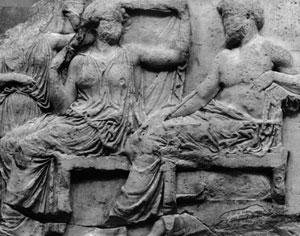
The Parthenon was begun in 447 BC on the site where construction of another temple had begun in 490 BC. The older temple, known as the Pre-Parthenon, was destroyed in 480 BC by the Persians before it was completed and its ruins were used in the construction of the northern walls, where one can still see many parts of columns. The poros foundations of the Pre-Parthenon survive, and allow us to conclude that this building was longer than the Parthenon. Some experts maintain that there was yet a third temple on the same site, of the 6th century BC, but there is disagreement among specialist archaeologists on the subject of this temple. One point of view is that all the architectural parts of the pediment, except one, in the museum belonged to it, while another theory is that they belonged to the old temple of Athena.
The architects of the Parthenon, which was the first building in Pericles' construction programme for the Acropolis, were Ictinus and Callicrates; the general supervisor of the works and the inspiration for the decoration, however, was the sculptor Phidias. The Parthenon is a peripteral Doric temple with 17 columns on its long sides and 8 on its short sides. It is of the amphiprostyle type, i.e. both short sides bear another colonnade before the cella walls. The cella itself is divided into two sections unequal in size. The eastern section was the larger and housed the chryselephantine (gold and ivory) statue of Athena which was surrounded by a colonnade in the shape of a II with ten Doric columns on the long sides and five crosswise. It was a two-storey Doric colonnade whose columns rose to roof beams and formed three aisles. Of these, the middle one, containing the gold and ivory statue of Athena was the widest. The western section was smaller. It is the Parthenon proper and its roof was supported by four Ionic columns which formed a square.
The two sections did not communicate; it is believed that the western section was the treasury of the city. The dimensions of the Parthenon of Classical times were, at the stylobate, 69.51 x 30.86 metres, in other words it was 4.5 metres wider than the Pre-Parthenon. The columns have a height of 10.40 metres and their diameter is 1.904 metres at the bottom and 1.481 metres at the top. These columns have twenty flutes.
The Parthenon, a monument destined to be more than a place of worship (indeed, it was a mirror of history and of the heroic achievements of the citizens of Athens), bore decorations on the pediments, on the frieze and the metopes. These decorations depicted subjects, the chief heroine of which was the mistress of the Acropolis, Athena Parthenos and were related to the city of Athens as well.
The metopes
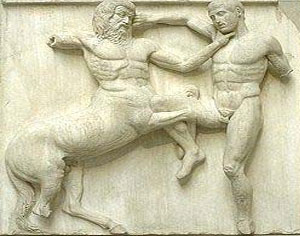
The metopes, 92 in total, were quarried while the monument itself was in the first stages of construction in 442-438 BC. They have a height of 1.2 metres and they were on the top. From the 92 metopes of the temple, 32 were framed on the north and 32 on the south side, and 14 on the east and 14 on the west side. The metopes on the outer colonnade depicted the Gigantomachy on the eastern side, the siege of Troy on the north, the battle of the Amazons on the west and the Centauromachy on the south. These motifs had been used on older monuments as well. On the Parthenon, however, these subjects were imbued with a special significance because the mythical references to the struggles of the Greeks against barbarity, tyranny and vulgarity were especially laden with meaning following the events and the heroic successes during the Persian Wars.
Naturally, the ravages of time and the destruction caused by the religious fervour of a later age caused great damage to the metopes of the Parthenon. The figures depicted were meticulously destroyed; only their outlines were left. Only one metope from the northern side -which depicts one standing and one seated figure which may have been interpreted and therefore accepted as a portrayal of the Annunciation- and parts of metopes of the southern face escaped this destruction. Of course, there are the ones that escaped Morosini's barrage, as well. Except for one or two, these were removed by Luisieri, working on behalf of Lord Elgin; one of them was taken by Choiseul-Gouffier, who sold it to the Louvre. In recent years, there has been a coordinated effort to complete the fragments that are displayed in the Museum of the Acropolis and to restore the central metopes of the southern face. The sketches of Jacques Carrey, who accompanied the Marquis of Nointel on his visit to Greece before the monument was damaged, have been an invaluable aid in this work.
The metopes of the eastern side, as well as three from the northern face, were removed from the monument for their protection in 1987 and are now displayed in the Museum. Those on the western face and the ones remaining on northern face are still in place.
The Frieze
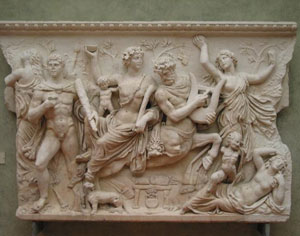
The upper parts of the walls of the cella, the pronaos and the opisthodomos are decorated by a running frieze, which measures 160 metres and has a height of one metre. This frieze consisted of stone blocks 60 cm thick which were part of the building. When they were removed by Lord Elgin they were cut in such a way as to remove most of the thickness, leaving "tiles" which were much easier and lighter to transport. The latest studies of the monument conclude that the compositions were sculpted directly on the monument. The frieze depicted the procession of the Panathenaean Games in an impressively clear and imaginative way with a great diversity of poses and figures. The skill used in creating this bas-relief, which has a maximum depth of only five centimetres, remains unsurpassed. In total, 190 figures are present - according to one interpretation, this is exactly the number of those who fell in the Battle of Marathon as mentioned by Herodotus.
The procession starts on the north-western corner of the building, while the second stone goes along the south face and also ends up on the eastern face; it has three stages - the gathering, the procession and the arrival. It is separated into two sections. The first takes up the entire west and north faces and ends on the eastern face. This is a superb composition of sheep, oxen, horses, riders, chariots, musicians, men bearing olive branches (the so-called thalophoroi), youths leading animals to be sacrificed, water-bearers, youths bearing baskets, masters of ceremony and priests. The imagination and skill of the artist who conceived and realised this work is made manifest in the festival atmosphere, the incredible variety of poses, the rendering of the clothing, the indescribably vivid movement of the animals. All this was to pay homage to the importance of the procession which is depicted: the Great Panathenaean Games, which took place every four years with all due pomp and with the participation of the citizenry of Athens.
The presentation of her new peplos (dress) to Athena is depicted on the eastern side. The twelve Olympian gods are also depicted gazing on this scene. They are portrayed sitting comfortably in their heavenly chambers, invisible to the masses. Athena, Hephaestus, Poseidon, Apollo, followed perhaps by Artemis and Aphrodite are sitting on the right side, while on the left there are Zeus, Hera, Ares, Demeter, Dionysus and Hermes. Eros was standing near Aphrodite and Nike was by Hera. On block no. VI of the eastern side, which was found to the east of the Parthenon in 1836, the gods of the first group (apart from Athena) were depicted. The sculpture of Eros, who was holding an alexhelios, a type of parasol, fell and was shattered. It still remains one of the most impressive and beautiful pieces of the frieze. The plethora of figures -mortals, gods and animals, to a total of 360 figures- testifies to the great importance of the Panathenaean Games to the citizens of Athens, both as a religious rite and as a social event.
Erichthonius, a king of mythical times, was considered to be the founder of these events to honour Athena, which proves beyond a shadow of a doubt that this festival, which in its early days was called "the Athenaea ; was rooted back in the mists of time. Under Theseus, who consolidated the clans of Attica, the festival was held by each demos on the 28th of the month of Hekatombaion. Every four years, however, the Great Panathenaea, a brilliant, four-day festival with many events, took place with the participation of all. It is thought that the Great Panathenaea first took place around 556 BC when the eponymous archon, or ruler, was Hippocleides and that they took place at the end of the Hekatombaion, which corresponds to our July. Before the highlight of the festival there were artistic competitions, dances performed by boys and girls, races with torches and athletic events. Then followed the main event, which was the procession which began from Kerameikos and ended, in the presentation of the goddess' peplos at the Parthenon. Large crowds flocked to take part in the events. There were also official delegations from cities allied to Athens and of cities who had Athenian colonists, who all took part in the procession with the elite of Athenian society.
It is said that Peisistratus was the one who established horse races, the nautical races and the nude games to accompany the pre-existing chariot races of the Great Panathenaean Festival. The torch race was a particularly favourite event. The victors of the events were awarded a panathenaean amphora, a special clay vessel filled with olive oil and Athenian olives, the so-called mories olives.
The Pediments
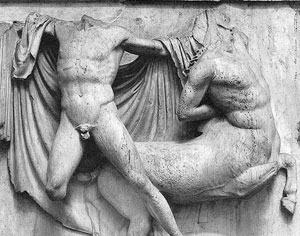
The decorations of the pediments of the Parthenon, 28 metres in length, were created in the years between 438-432 BC and depicted the birth of Athena (east) and the contest between Athena and Poseidon (west). Pausanias characteristically noted that:
The sculptures of both pediments are found, for the most part, at the British Museum, while there are a few pieces at the Acropolis Museum. The chief figures on the eastern pediment are Zeus and Athena, while Poseidon and Athena are represented on the west. There are fifty figures in total, gods and heroes, who gaze on these scenes.
The sculpted decoration of the Parthenon is completed by the four rain spouts which were in the shape of lions' heads and were placed at the four corners of the roof, as well as the two acroterions in the shape of palmettes with spiny leaves, one each at the top of each pediment. Finally, note must be made of the fact that the visitor to the Parthenon in antiquity would have been dazzled by several details: the many colors used to paint the figures (it is well known that all ancient temples were painted with vivid colors, as were statues), the placement of statues in such a way as to be seen in the round and the optical illusions - i.e. the upward curvature of all horizontal lines and the slight divergence from the true vertical which completed the illusion. It has been calculated that the central axes of each column would meet at a height of 1850 metres above their bases if one were to extend them in one's imagination. The optical illusions continue in the phenomenon of entasis, i.e. that the columns have a greater diameter just below their mid-point and that the columns at the corners are separated by a smaller distance so that their mass does not appear to be reduced by the light of the sky in the background.
Nowadays, in order to preserve these incomparable monuments -the Parthenon, the Erechtheion, the Temple of Athena Nike and the Propylaea- for future generations, extensive and lengthy works have been undertaken. The other two aims of these works are to restore the buildings on the Sacred Rock of the Acropolis and to exhibit them. Restoration works had already begun a short while after Greece declared its independence, in 1821, and the work has continued ceaselessly since then.
